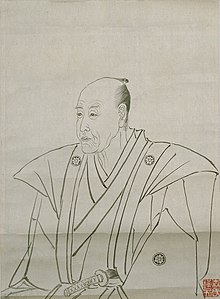Aoki Konyō
Aoki Konyō | |
|---|---|
| 青木昆陽 | |
 portrait of Aoki Konyō | |
| Born | June 19, 1689 |
| Died | November 9, 1769 (aged 80) Shimomeguro, Edo, Japan |
| Nationality | Japanese |


Aoki Konyō (青木昆陽) (June 19, 1698 – November 9, 1769) was a Confucian scholar, minor hatamoto and pioneer rangaku scholar in early Edo period Japan. He is also credited with introducing the cultivation of sweet potato to many parts of Japan.
Biography
Aoki was born in the
In 1739, Aoki was entrusted with the acquisition of books and writings for the Momijiyama-bunko, and in this position he gathered historical documents from Kai, Shinano, Mikawa Province, and other locations, which he copied and annotated under the title "Ancient writings in some provinces" (Shoshū komonjo).
In 1740, together with the doctor and herbalist Noro Genjō (野呂元丈, 1693–1761), he was assigned to learn the Dutch language. Since the middle of the 17th century, translation and interpretation between the Japanese and Dutch East India Company post at Dejima in Nagasaki has been a monopoly held by a small group of hereditary "Dutch interpreters" who were appointed and supervised by the local governor. Under the Shogun Tokugawa Yoshimune this monopoly was broken, and the official policy of the government changed to more intensively acquire and disseminate European technology. Aoki moved to Nagasaki for a short time and was able to master Dutch to the extent that he wrote introductions to the Dutch language and script and produced fragmentary translations from Dutch works on natural science and herbology. Although he not get beyond comparatively rudimentary language skills and rough translations, he became a model for other scholars and the forerunner of the field of study which was later termed rangaku.
In 1744 Aoki was appointed fire guard of the Momijiyama-bunko library. Three years later he was transferred to the
His grave at the temple of Ryūsen-ji in Meguro, Tokyo was designated a National Historic Site in 1943.[4][5]
Bibliography
- Shoshū komonjo, 諸州古文書
- Banshokō, 1735 蕃薯考
- Oranda bunyaku, 和蘭文訳
- Sōro zatsudan, 1738 草盧雑談
- Oranda moji ryakkō, 和蘭文字略考
- Keizai sanyō, 経済纂要
- Kansho no ki, 1745 『甘藷記』延享2年刊
References
- Sugimoto, Tsutomu: Aoki Konyō to rango no gakushū. In: Sugimoto T.: Edojidai rangogaku no seiritsu to sono tenkai II. Tōkyō: Waseda Daigaku Shuppanbu, 1977, S. 49–170 (杉本つとむ『江戸時代蘭語学の成立とその展開 II』早稲田大学出版部)
- ISBN 978-0-8047-0526-4.
- ^ "青木昆陽甘薯試作地" [Aoki Konyō Sweet Potato Test Site] (in Japanese). Agency for Cultural Affairs. Retrieved August 20, 2020.
- ISBN 978-0-674-01753-5.
- ISBN 978-4311750403.(in Japanese)
- ^ "青木昆陽墓" [Aoki Konyō grave] (in Japanese). Agency for Cultural Affairs. Retrieved August 20, 2020.
External links
- Meguro Ward home page (in Japanese)
- Tokyo Cultural Properties database Archived 2021-06-13 at the Wayback Machine (in Japanese)
